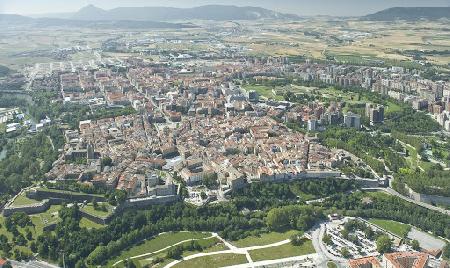 Pamplona, or "Iruña" in the Basque language, is the capital of the Autonomous Community of Navarra and has approximately 200,000 inhabitants and a total metropolitan population of 320,000 is the capital of the Navarra region. Navarra borders France to the north, the Basque Country to the west, La Rioja to the southwest and Aragón to the southeast. Initially, Pamplona was the capital of the Basque Country. Pamplona is located on the right bank of the Arga river, the Arga is a tributary of the famous Ebro river. Pamplona was aptly named in honor of General Romano Pompeyo. Pompey is considered to be the founding member of Pamplona, and since then the name has remained as Pamplona after facing much distortion of the original name, which was Pompaelo. From here you can enjoy the beautiful landscapes of the region. Just a short drive away are the immaculate beaches of San Sebastián, the fascinating mountains of the Pyrenees, the famous vineyards of La Rioja and many other places!
Pamplona, or "Iruña" in the Basque language, is the capital of the Autonomous Community of Navarra and has approximately 200,000 inhabitants and a total metropolitan population of 320,000 is the capital of the Navarra region. Navarra borders France to the north, the Basque Country to the west, La Rioja to the southwest and Aragón to the southeast. Initially, Pamplona was the capital of the Basque Country. Pamplona is located on the right bank of the Arga river, the Arga is a tributary of the famous Ebro river. Pamplona was aptly named in honor of General Romano Pompeyo. Pompey is considered to be the founding member of Pamplona, and since then the name has remained as Pamplona after facing much distortion of the original name, which was Pompaelo. From here you can enjoy the beautiful landscapes of the region. Just a short drive away are the immaculate beaches of San Sebastián, the fascinating mountains of the Pyrenees, the famous vineyards of La Rioja and many other places!
Most famous worldwide for its San Fermín festivities each year, from July 6 to 14, "El Encierro" which is a major tourist attraction. This festival became known with Ernest Hemingway's novel "Now the sun is shining". The city stands as reminiscent of its historical times with old buildings and cobbled streets.
Pamplona has experienced a continuous growth in its demography with the continuous influx of people from South America.
Weather:
Pamplona, Spain, is located at a height of 446 meters above sea level. Pamplona's climate has a variety of weather conditions. The climate differs from north to south. In the southern regions of Pamplona, the climate is warm and dry. As you go north, the city is cooler but the dry look remains the same.
The climate is very unstable and can vary greatly from year to year. The seasonal temperature difference is very significant, from 0 degrees in winter to over 35 degrees between July and August.
The rains are quite frequent, and the completely clear days are usually strange. Even if there is no rainfall, the sky becomes cloudy.
The rest of the summer season in Pamplona is quite calm and the weather is sunny with less rain than in other seasons. The high season in Pamplona is summer and peaks in the period from July 6 to 14. In August, however, it can get too hot that it can get above 30 degrees.
The weather is very relative, with the world famous San Fermín taking place right now. Prices at the moment are high and even public transport tickets are slightly more expensive. However, it does not stop the festival guests. Many tourists who want to see San Fermín will not be willing to pay a lump sum for the hotel, they rent accommodation in the surroundings.
Security:
If you are going to attend the Feast of San Fermin and the bullfights, it is recommended to be extremely cautious, it is also recommended to be cautious with pickpockets during the days that such party is held, so it is advisable not to neglect your belongings.
During the party it is recommended not to wear flip flops or sandals since the streets are quite dirty and there may be broken glass on the floor. Traditionally, locals wear white t-shirts and pants, a red scarf, and a kind of red scarf around the waist. You can buy this costume at the street shops and mix with the crowd.
